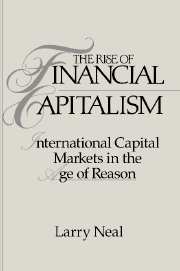Book contents
- Frontmatter
- Contents
- Acknowledgments
- 1 Historical background for the rise of financial capitalism: commercial revolution, rise of nation-states, and capital markets
- 2 The development of an information network and the international capital market of London and Amsterdam
- 3 The early capital markets of London and Amsterdam
- 4 The Banque Royale and the South Sea Company: how the bubbles began
- 5 The Bank of England and the South Sea Company: how the bubbles ended
- 6 The English and Dutch East Indies companies: how the East was won
- 7 The integration of the English and Dutch capital markets in peace and war
- 8 The English and Dutch capital markets in panics
- 9 The capital markets during revolutions, war, and peace
- 10 A tale of two revolutions: international capital flows, 1792–1815
- 11 The Amsterdam and London stock markets, 1800–25
- Appendix End-of-month share prices
- Bibliography
- Index
3 - The early capital markets of London and Amsterdam
Published online by Cambridge University Press: 25 March 2010
- Frontmatter
- Contents
- Acknowledgments
- 1 Historical background for the rise of financial capitalism: commercial revolution, rise of nation-states, and capital markets
- 2 The development of an information network and the international capital market of London and Amsterdam
- 3 The early capital markets of London and Amsterdam
- 4 The Banque Royale and the South Sea Company: how the bubbles began
- 5 The Bank of England and the South Sea Company: how the bubbles ended
- 6 The English and Dutch East Indies companies: how the East was won
- 7 The integration of the English and Dutch capital markets in peace and war
- 8 The English and Dutch capital markets in panics
- 9 The capital markets during revolutions, war, and peace
- 10 A tale of two revolutions: international capital flows, 1792–1815
- 11 The Amsterdam and London stock markets, 1800–25
- Appendix End-of-month share prices
- Bibliography
- Index
Summary
The origins of the joint-stock companies that arose in the great longdistance trades of the seventeenth century in western Europe lie at least as far back as the medieval societas maris and commenda. These were forms of limited-liability partnerships used extensively in merchant shipping to reduce risks by making specific arrangements regarding the sharing of profit (or loss) for each voyage. Partners were divided into investors, who stayed on land, and travelers, who went with the ship. In the commenda, the voyager risked no capital, only his life, and received one-fourth of the profits, whereas in the societas the voyager put up one-third of the capital and shared equally in the profits. The commenda is believed to have derived from the practices of Arab shipping fleets in the Mediterranean during the Islamic expansion of the eighth to fifteenth centuries. W. R. Scott, in his classic work The Constitution and Finance of English, Scottish and Irish Joint-Stock Companies to 1720, distinguished three processes that led to the joint-stock companies of seventeenth-century England. One was to divide up among member merchants the corporate purchases made by the early regulated companies used by the British to carry on foreign trade (i.e., to share in the overhead costs). Examples are the Merchant Adventurers (export of cloth), the Staple (export of wool), and the Levant Company. The second was to extend the societas used by the Italian financiers in England during the thirteenth and fourteenth centuries to divide up and pay out profits to partners on a regular basis (i.e., to monitor and manage the activities of far-flung partners).
- Type
- Chapter
- Information
- The Rise of Financial CapitalismInternational Capital Markets in the Age of Reason, pp. 44 - 61Publisher: Cambridge University PressPrint publication year: 1991



